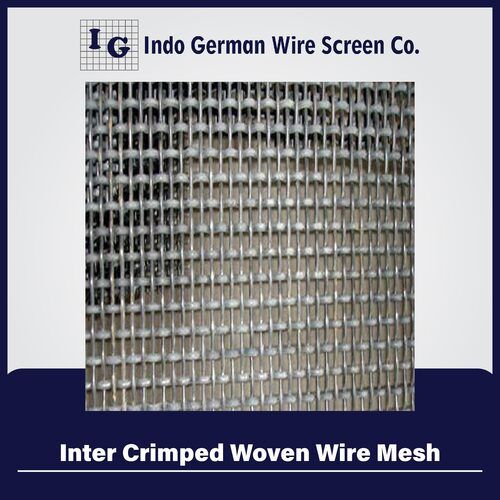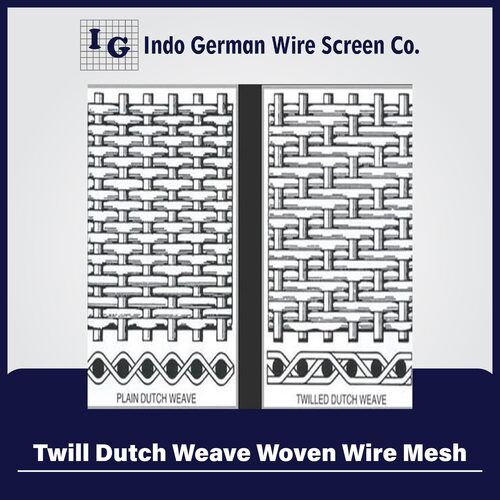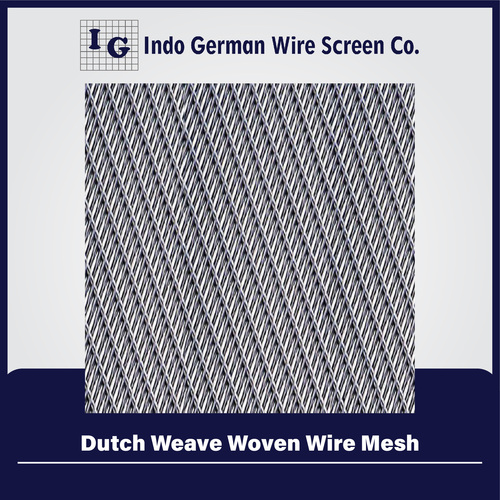Five Shed Twill Weave Woven Wire Mesh
Price 50 INR/ Unit
Five Shed Twill Weave Woven Wire Mesh Specification
- Hole Shape
- Rectangular
- Aperture
- 0.1 mm to 4 mm
- Length
- 30 meters standard roll length
- Surface Treatment
- Coated
- Wire Gauge
- 32 to 14 SWG
- Product Type
- Wire Cloth
- Mesh Type
- Five Shed Twill Weave
- Mesh Style
- Woven Mesh
- Material
- Metal Alloys
- Alloy
- Stainless Steel 304, 316, others
- Application
- Other
- Dimensions
- Customized, standard width up to 1.5 meters
- Wire Diameter
- 0.2 mm 2 mm
- Weight
- Varies with aperture and wire gauge
- Color
- Silver
Five Shed Twill Weave Woven Wire Mesh Trade Information
- Minimum Order Quantity
- 1 Unit
- Supply Ability
- 5000 Units Per Month
- Delivery Time
- 7 Days
About Five Shed Twill Weave Woven Wire Mesh
Precision Weave for Enhanced Performance
The five shed twill weave structure provides superior mechanical strength and improved filtration capabilities. This intricate weaving pattern delivers both durability and flexibility, making the mesh ideal for heavy-duty industrial use and precise separation tasks.
Versatile Applications Across Industries
Engineered for versatility, this woven wire mesh is widely used in filtration systems, industrial separation, sifting operations, protective covers, and decorative architectural elements. Its adaptability to different environments arises from the range of available materials and surface treatments.
Custom Sizing and Specifications Available
Five Shed Twill Weave Mesh can be tailored to project requirements, with options for wire gauge, aperture size, length, width, and edge finishes. Whether you need standard rolls or sheets, or something fully bespoke, customization ensures optimal compatibility with your application.
FAQs of Five Shed Twill Weave Woven Wire Mesh:
Q: How is the five shed twill weave different from standard woven mesh patterns?
A: The five shed twill weave employs a unique pattern in which each wire passes alternately over four and under one wire, resulting in higher density and strength compared to plain or traditional twill weaves. This design enhances the meshs ability to handle heavy loads and fine filtration.Q: What materials are used for the mesh and how do they benefit the application?
A: Typically crafted from stainless steel alloys such as 304 or 316, the mesh offers outstanding corrosion resistance and durability. These materials ensure effective performance in harsh industrial and chemical environments where longevity and reliability are crucial.Q: When should I choose cut edge versus welded edge mesh?
A: Cut edges are suitable for general filtration or protective uses where edge integrity is less critical. Welded edges, on the other hand, provide added stability and are recommended for applications demanding resistance to fraying or enhanced durability during handling and installation.Q: Where can five shed twill weave mesh be effectively utilized?
A: This mesh is commonly used in filtration, industrial separation, sifting, protective screens, and architectural decoration. Its robust design makes it suitable for industries such as chemical processing, mining, food, and construction.Q: What is the process of customizing mesh specifications for my requirement?
A: Customization involves selecting desired aperture size, wire gauge (32 to 14 SWG), length, width (up to 1.5 meters), edge finishing, and alloy type. Manufacturers can assist in determining the best configuration to meet your operational challenges and performance needs.Q: How does the open area percentage impact filtration or sifting performance?
A: The open area, ranging from 30% to 65%, influences the meshs flow rate and particle retention. Higher open area allows increased material passage but may reduce filtering precision, while lower open area ensures finer filtration and improved particle separation.

Price:
- 50
- 100
- 200
- 250
- 500
- 1000+
More Products in Woven Wire Mesh types Category
Double Crimped Woven Wire Mesh
Price 50 INR / Unit
Minimum Order Quantity : 1 Unit
Material : Metal Alloys
Application : Other
Color : Silver
Mesh Style : Crimped Wire Mesh
Inter Crimped Woven Wire Mesh
Price 50 INR / Unit
Minimum Order Quantity : 1 Unit
Material : Metal Alloys
Application : Other
Color : Silver
Mesh Style : Crimped Wire Mesh
Twill Dutch Weave Woven Wire Mesh
Price 50 INR / Unit
Minimum Order Quantity : 1 Unit
Material : Stainless Steel
Application : Other, Filtration, Sifting, Sieving
Color : Silver
Mesh Style : Woven Mesh
Dutch Weave Woven Wire Mesh
Price 50 INR / Unit
Minimum Order Quantity : 1 Unit
Material : Other, Stainless Steel, Brass, Copper
Application : Other, Filtration, Sieving, Industrial, Chemical Processing
Color : Silver
Mesh Style : Other , Dutch Weave
 |
INDO GERMAN WIRE SCREEN CO.
All Rights Reserved.(Terms of Use) Developed and Managed by Infocom Network Private Limited. |
 English
English Spanish
Spanish French
French German
German Italian
Italian Chinese (Simplified)
Chinese (Simplified) Japanese
Japanese Korean
Korean Arabic
Arabic Portuguese
Portuguese
 Send Inquiry
Send Inquiry




